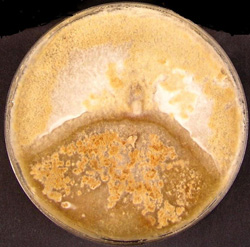Summary
As Chalara ash dieback disease caused by the fungal pathogen Hymenoscyphus fraxineus invades Britain, the aim of this research is to gain a better understanding of the pathogen in terms of its behaviour, genetics and interaction with the native H. albidus.
Research Objectives
The initial objectives of this research are to:
- Assess the extent of diversity in recently arrived populations of H. fraxineus by exploring the genetic recognition system of the fungus known as vegetative compatibility.
- Compare the diversity of H. fraxineus and H. albidus and how they may be interacting.
General Content
Background
Two species of Hymenoscyphus have become well know in Britain since the arrival of ash dieback. The recently arrived damaging pathogen of European ash (Fraxinus excelsior) H. fraxineus is an out-crossing species of Ascomycete fungus that is native to East Asia. The almost identical looking, H. albidus is an often-overlooked native species that is also associated with European ash, with the earliest record in Britain dating back to 1876. It is inbreeding and its association with ash has little or no impact on tree health. Both fungi infect healthy leaves of ash during summer and fruit on the remains of the fallen leaves the following year, producing sexually produced spores which are dispersed aerially.
Results

Our work has shown that the ash dieback pathogen, H. fraxineus, has a somatic self–nonself recognition or vegetative compatibility ‘vc’ system, that is readily expressed in culture. It is the equivalent of a tissue-rejection system in humans and enables some fungi to distinguish between self and non-self genotypes in culture and nature. For H. fraxineus, the vc reactions appears as gaps or pigmented lines when individuals are paired in culture. Similar reactions are seen in naturally infected ash leaves indicating this recognition process also takes place in nature. Even at the start of the epidemic, almost every individual of H. fraxineus that we tested was a unique vc-type suggesting high genetic diversity even at local population levels which is probably sustained through sexual reproduction and recombination of v-c genes.
Hymenoscyphus albidus also has a similar ‘vc’ system, and again each individual that was tested was a unique vc-type. However, we also discovered that across eight sites in southern Britain where previously only H. albidus had been present, the invading H. fraxineus appeared to replace H. albidus and made it difficult to detect fruit bodies of the latter. It has been suggested that habitat invasion by H. fraxineus may lead to the extinction of H. albidus across Europe.
Status
Completed. The project started in April 2013 and was completed in 2019.
Related resources
Publications
- Hymenoscyphus fraxineus and vegetative incompatibility
https://www.sciencedirect.com/science/article/pii/S1754504813001049 - Hymenoscyphus albidus and vegetative incompatibility
https://www.sciencedirect.com/science/article/pii/S1754504817300375 - Multiplex PCR assay to discriminate Hymenoscyphus albidus and H. fraxineus
https://www.sciencedirect.com/science/article/pii/S175450481630068X
Further information
Funders and partners
This research project was funded by the Forestry Commission Advice and scientific support for tree health programme and undertaken in partnership with Forestry Commission England Plant Health.
Forestry Commission policy
This research underpins the evidence base for the delivery of healthy and resilient forests and wider ecosystems which is part of the Tree Health and Plant Biosecurity Action Plan.
